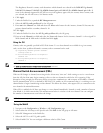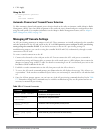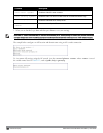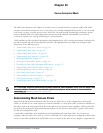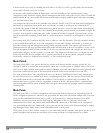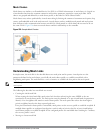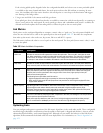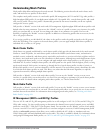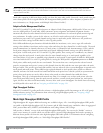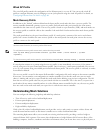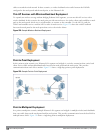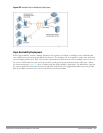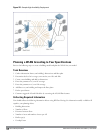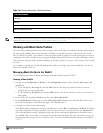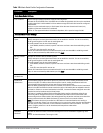
444 | SecureEnterpriseMesh DellPowerConnectW-SeriesArubaOS6.2 | User Guide
NOTE: If you do not want the mesh radios carrying mesh-backhaul traffic to support client traffic, consider using a dedicated
802.11a/80211/g radio profile with the mesh radio disabled: in this scenario, the radio carries mesh backhaul traffic but does not
support client Virtual APs.
Mesh nodes operating in different cluster profiles can share the same radio profile. Conversely, mesh portals using the
same cluster profile can be assigned different RF Management Radio profiles to achieve frequency separation (for
more information, see “Deployments with Multiple Mesh Cluster Profiles”).
Adaptive Radio Management Profiles
Each 802.11a and 802.11g radio profile references an Adaptive Radio Management (ARM) profile. When you assign
an active ARM profile to a mesh radio, ARM's automatic power-assignment and channel-assignment features
automatically select the radio channel with the least amount of interference for each mesh portal, maximizing end
user performance. In earlier versions of this software, an AP with a mesh radio received its beacon period,
transmission power and 11a/11g portal channel settings from its mesh radio profile. Mesh-access AP portals now
inherit these radio settings from their dot11a or dot11g radio profiles.
Each ARM-enabled mesh portal monitors defined thresholds for interference, noise, errors, rogue APs and radar
settings, then calculates interference and coverage values and selects the best channel for its radio band(s). The mesh
portal communicates its channel selection to its mesh points via Channel Switch Announcements (CSAs), and the
mesh points change their channel to match their mesh portal. Although channel settings can still be defined for a
mesh point via that mesh point's 802.11a and 802.11g radio profiles, these settings are overridden by any channel
changes from the mesh portal. A mesh point takes the same channel setting as its mesh portal, regardless of its
associated clients. If you want to manually assign channels to mesh portals or mesh points, disable the ARM profile
associated with the 802.11a or 802.11g radio profile by setting the ARM profile’s assignment parameter to disable.
Mesh points, unlike mesh portals, do not scan channels. This means that once a mesh point has selected a mesh
portal or an upstream mesh point, it tunes to this channel, forms the link, and does not scan again unless the mesh
link gets broken. This provides good mesh link stability, but may adversely affect system throughput in networks with
mesh portals and mesh points. When ARM assigns optimal channels to mesh portals, those portals use different
channels, and once the mesh network has formed and all the mesh points have selected a portal (or upstream mesh
point), those mesh points are not be able to detect other portals on other channels that could offer better
throughput. This type of suboptimal mesh network may form if, for example, two or three mesh points select the
same mesh portal after booting, form the mesh network, and leave a nearby mesh portal without any mesh points.
Again, this does not affect mesh functionality, but may affect total system throughput. For details about associating
an ARM profile with a mesh AP, see "Assigning an ARM Profile" on page 430.
High-Throughput Profiles
Each 802.11a and 802.11g radio profile also references a high-throughput profile that manages an AP or AP group’s
40Mhz tolerance settings. For information about referencing a high-throughput profile, see "Assigning a High-
throughput Profile" on page 429.
Mesh High-Throughput SSID Profile
High-throughput APs support additional settings not available in legacy APs. A mesh high-throughput SSID profile
can enable or disable high-throughput (802.11n) features and 40 MHz channel usage, and define values for aggregated
MAC protocol data units (MDPUs) and Modulation and Coding Scheme (MCS) ranges.
Dell provides a “default” version of the mesh high-throughput SSID profile. You can use the “default” version or
create a new instance of a profile which you can then edit as you need. High-throughput Mesh nodes operating in
different cluster profiles can share the same high-throughput SSID radio profile. For information about configuring
mesh high-throughput SSID profiles, see “Mesh High-Throughput SSID Profiles”.



